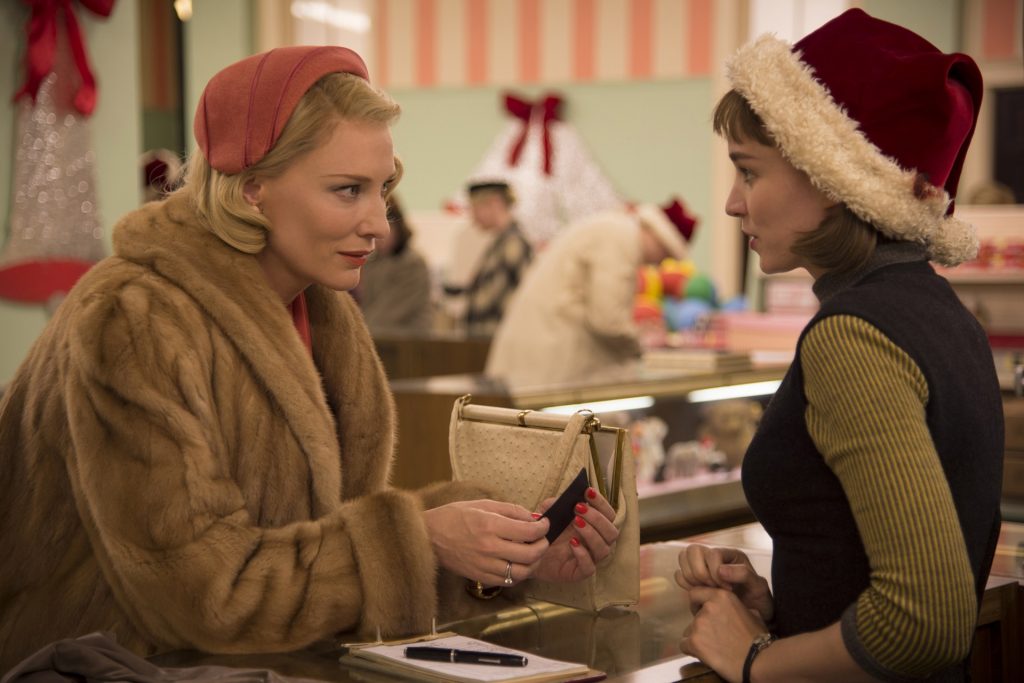Carol, the film adaptation of Patricia Highsmith’s revolutionary novel The Price of Salt, does not disappoint. Highsmith’s 1952 novel was the first LGBT book to not end in catastrophe, conversion or death. Carol can be considered revolutionary in the same way because it’s (FINALLY) a non-hetero romance film done right.
I am elated this piece does not call for a rant on what should have been. The very intimate glances, simple touches shared between Carol (Cate Blanchett) and Therese (Rooney Mara) sent shivers down my spine. I was transported back to the 50s, portrayed with excellent set and costume design. Unlike the gal-pal dynamic between Jenny and Kitty in Jenny’s Wedding, no one doubts the connection felt on screen between Carol and Therese. Carol surpasses Jenny’s Wedding in every cinematic aspect. Long, drawn-out verses of “She Keeps Me Warm” are replaced with a beautifully fitting score composed by Carter Burwell, which carries the plot in a way that brings Stephen Daldry’s The Hours to mind.
Much of the film is Therese’s reactionary behavior in response to Carol. It’s said that every camera angle, every shot serves a purpose in movies, there are no accidents. I praise director Todd Haynes for his very intentional camera placement. We view Therese’s world through her eyes, and by “world” I mean Carol. We too are arrested by Carol’s warmly soothing voice. We are then detached completely from the young woman, viewing her from the outside. She sits on a train, ambushed by the intense isolation felt when falling in love. These positions allow the audience to vicariously experience what Therese is going through, to then empathize with her, drawing us closer. There is one disruption, one spiteful interruption that occurs in the plot. But the saying “love conquers all” suits the occasion because while Carol’s soon-to-be ex-husband (Kyle Chandler) is holding onto the last string he has connected to the woman he still loves, the focus, from the moment Therese is struck in awe by Carol’s presence, remains the love they share for each other. The rest is background.
Now, I shouldn’t neglect to mention Patricia Highsmith’s novel The Price of Salt, the original story from which Carol is derived. There are just some emotions that can only be experienced, unseen and only felt through words read on a page. Highsmith poetically expresses the experience that is so well visually conveyed throughout the film. However, what struck me the most were the moments of detachment, viewing Therese from the outside. She glances over her shoulder in a record shop, two women are standing by the window and notice they are being looked at. One is wearing a suit. Therese turns back around. In the movie it appears a trivial detail provided only to show the audience those who were perceived as “other.” However, the novel explains that while Therese is falling in love with a woman, neither of them “look like that,” neither of them fit into that box. And I think that is one very important theme to wake up to from both works. We may be in year 2016, but we are not far from the 50s. Don’t we still try to label ourselves and others, fit them into some socially constructed definition? Perhaps that simple glance was a gesture from Haynes. A nudge to realize that it is time to move on, just as the film’s ambiguously positive ending suggests that both Carol and Therese will too be moving on, together.




Comments are closed.